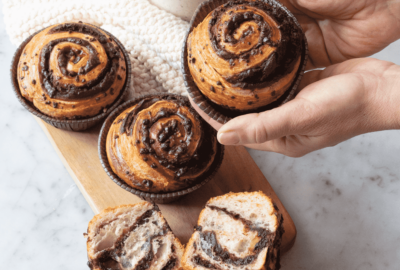Superfood sales have soared globally in the last few years led by wellness-obsessed Americans following healthy and ‘clean’ diets. It’s an eating trend which has fast gained popularity this side of the Pond and chefs are being increasingly asked to incorporate so-called “superfoods” into their dishes. Demand in the UK is being further driven by consumers wanting to know about the provenance of their food. Mintel researchers say there has been a 202% increase in the number of new food and drink products launched globally containing the term “superfood” so how easy is it to include the likes of quinoa, moringa, spirulina and baobab into your menus? Here, six creative chefs flex their muscles and show how you can incorporate superfoods onto your menu…
Superfoods explained:
Quinoa A wheat-free alternative to starchy grains from the same family as beets and spinach. The seeds can be added to cereals and salads and also used as side dishes.
Spirulina A blue-green algae packed with nutrients and high in protein.
Moringa Virtually every part of the moringa tree is edible and the easiest way to consume it is in powder form (made from the dried leaves). It has 25 times the amount of iron than spinach and seven times more vitamin C than oranges.
Baobab The Baobab tree is known as the “Tree of Life” and its fruit is full of vitamins, fibre and twice the calcium of milk.
Ben Bartlett, celebrity chef and brand ambassador for Lion sauces A superfood salad makes an incredible power lunch and a fortifying alternative to a sandwich. Use sustainable wild salmon, baked, grilled or hot smoked, with a mixture of baby spinach leaves, avocado, shredded carrot, red onion, cherry tomatoes, finely diced cucumber, quinoa and flax seed, brought to life with Lion Cajun & Tomato Dressing. It’s lean, packed with protein, vitamins and fibre, and both satisfying and refreshing. The great news is that most of the ingredients are probably already in your kitchen – and familiar enough to serve in almost any setting, from cafés to care homes and schools.
Fergus Martin, Major’s new development chef and former head chef at Darwin College, Cambridge Quinoa is a great ingredient to include in your recipes and boast on your menu, as it taps perfectly into consumer desires for ‘clean’ diets and healthy eating. Try a black quinoa vegan sushi or a warm Moroccaninfused grain salad with a serving of marinated fish or meat for your grab and go options, or even in your winter soups or Pan-Asian broths. Furthermore, with recent research proving that regular consumption of quinoa is great for controlling or preventing diabetes or hypertension, helping to reduce blood glucose levels and lower blood pressure, it is a great ingredient to use in the care sector too.
Steve Smith, head chef at Michelin-starred Bohemia, Jersey www.bohemia jersey.com In recent months we have seen such a huge demand for superfoods. We’ve become very aware of the growing trend so we are incorporating them into our tasting menus more and more. At Bohemia we are constantly updating our menus to work with the seasons and new trends. For 2017 we are experimenting with new dishes which include superfoods such as baobab and quinoa. Baobab works well in muffins with peach and mango, or for a savoury dish baobab tastes great in a soup with coconut and chilli mushrooms. On our current winter menu we have included beetroot, which is a superfood, in our Venison loin & ragut dish. Beetroot is a fantastic and easy superfood to use in dishes and contains a lot of vitamins, minerals and antioxidants.
Oliver Smith, head chef at Hadrian Healthcare Group’s Wetherby Manor and winner of the NACC Care Cook of the Year award 2015 Superfoods are nothing new. We make menus around nutritious foods to benefit our residents’ health. By adding nuts and berries to muesli and adding vegetables like beetroot to cakes, we can find ways to enhance various dishes. Our residents often have specific dietary needs and preferences, and we discuss these with them in detail and choose the best foods for them to devise individual menus if that is required. Choosing high water content foods such as juicy fruits can also help with hydration for people for whom that may be necessary.
Hina Patel, food activation manager, Nestlé Professional Allergen-aware consumers are increasingly seeking alternatives to wheat. People following a gluten-free diet or healthier diet should opt for gluten-free options such as millet, corn, quinoa and polenta. Superfoods are not only healthy but can also make delicious meals which are easy to prepare such as quinoa tabbouleh which uses staple fridge and cupboard ingredients, such as lemon, parsley, spring onions, tomatoes and Maggi Liquid Concentrates (stock). For a meatier version, add tinned sardines or leftover meat. Not only does it look appetising, it’s super tasty too! Or impress your guests with the Root Vegetable Quinoa Casserole made with brown rice, quinoa, butternut squash, mixed fresh herbs and splash of stock. Very simple yet delicious and healthy. For a twist, add some chillies to give a fiery kick. For full recipes, please visit the recipes section of the Stir it up website.
Preston Walker, active member and supporter of the National Association of Care Catering (NACC) and director and chef at Oak House Care Home Superfoods are great for increasing nutrients in the diet, particularly for the elderly who can have suppressed appetites. It’s important to be innovative to ensure they are enjoyed by residents. We’ve developed a delicious custard dessert using sweet potatoes and red lentils, for example, and we include super-fruits in smoothies and make vegetable dishes more appealing with tasty sauces and herb crusts.


